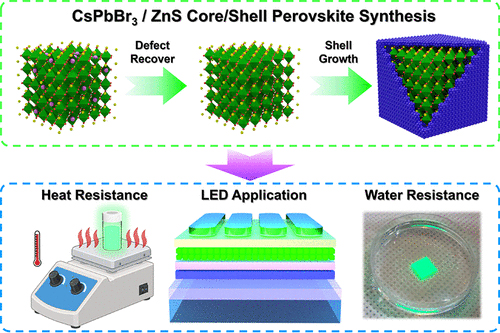Surface Defect Recovery in Perovskite Nanocrystals with Excess Halide for Core–Shell Structure
- 저자
- Dong Hyeon Lee, Woo Hyeon Jeong, Seokhyun Choung, Ji Won Jang, Gyudong Lee, Hochan Song, Sanghun Han, Gyeong Eun Seok, Jihoon Kim, Myeonggeun Han, Jeong Woo Han, Hyosung Choi, Jongmin Choi*, Bo Ram Lee*, Yong-Young Noh*
- 저널명
- ACS Energy Letters, 9, 11, 5413–5420 (2024)
- 년도
- 2024
- Link
- https://doi.org/10.1021/acsenergylett.4c01870 627회 연결
[Abstract]
We present a method to synthesize stable and uniform high-quality perovskite nanocrystals (PNCs) by using excess halide to recover surface defects in CsPbBr3/ZnS core/shell nanocrystals. Use of N-bromosuccinimide as a halide donor recovered surface halide vacancies of bare CsPbBr3 PNCs during the growth of the ZnS shell, as confirmed by DFT calculations. This approach achieves a high photoluminescence quantum yield of nearly 1, and significantly increases the stability of PNCs under adverse conditions such as high humidity and elevated temperature. CsPbBr3/ZnS PNC light-emitting diodes demonstrated outstanding luminous characteristics, with a remarkable external quantum efficiency of 12.77% and a maximum luminance of 1449 cd m–2 at 517 nm. These characteristics of the PNCs will have a wide variety of applications and will help enable development of highly efficient optoelectronic devices.
- 이전글Effects of high capacitance of solution-processed polymer heterojunction gate dielectrics on the contact resistance of low-voltage n-channel organic transistors 25.01.17
- 다음글Chemically Self-Assembled Monolayer Semiconducting Single-Walled Carbon Nanotube-Based Biosensor Platform for Amyloid-β Detection 25.01.17
